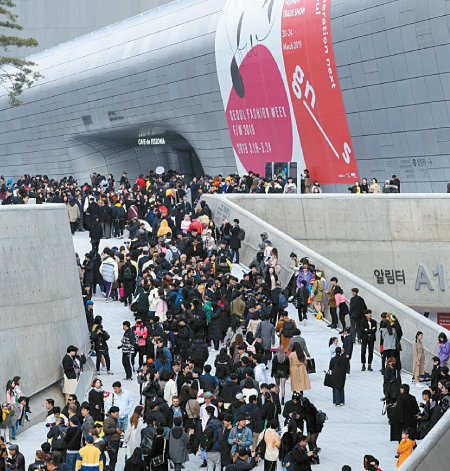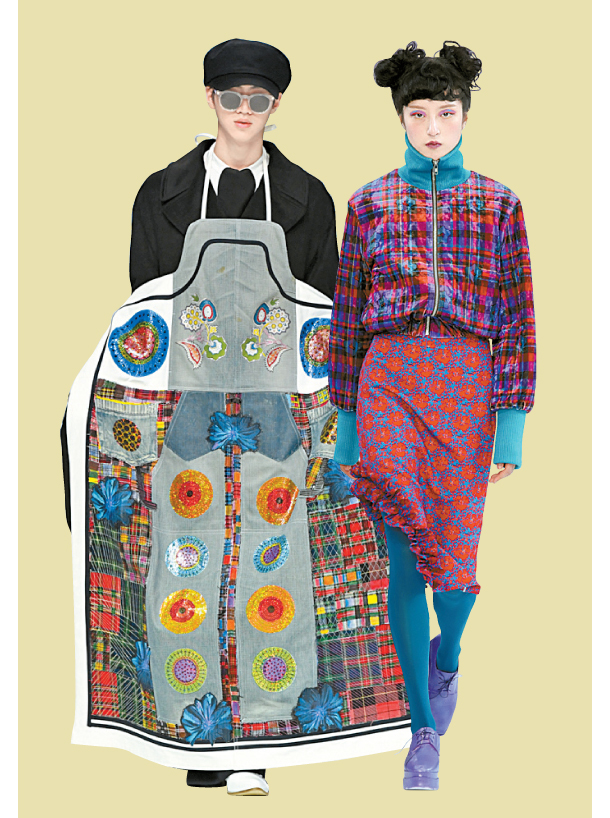Seoul Fashion Week breaks barriers: Collections from local and British designers challenged gender roles, featured Korean motifs

Thousands of fashion enthusiasts crowd Dongdaemun Design Plaza, central Seoul, for the 2019 F/W Seoul Fashion Week. [SEOUL FASHION WEEK]
Although there was no opening show to kick off the six-day event due to changes in sponsorship, crowds of sharply-dressed fashionistas made their way to Seoul’s Dongdaemun Design Plaza (DDP) to attend around 50 shows, participate in exclusive portfolio reviews and attend an insightful seminar on the future of e-commerce. Some 95 brands participated in the trade show, making it the largest-ever edition for the fall/winter season.
Those without tickets to the event inside had their fair share of excitement too, with multiple photo zones placed across the plaza square and unprecedented access to “Generation Next” brand fashion shows featuring 20 new designers, which were held outdoors.
The following are some highlights from this season’s collections.

From left: Caruso gives a nod to men in the kitchen. SETSETSET pays tribute to Korean patriots through mugunghwa, the national flower of Korea, designs. [SEOUL FASHION WEEK]
British menswear label Cottweiler’s Friday showcase was easily the highlight, if not the most significant moment, of this year’s fashion week.
In an underground garage-turned runway venue that seats 500, the multi-award winning menswear label, headed by duo Ben Cottrell and Matthew Dainty, presented its fall/winter collection titled “The Lost Art of Cruising,” featuring various shades of “moss green” designs that challenged “traditional masculine dress codes.” An all-Korean cast of models donned crop tops, polo shirts and cargo pants, walking with surprising speed and energy in front of a diverse audience that included several British fashion insiders who came to celebrate the brand’s local debut.
Cottweiler is the first British brand to present their collection at Seoul Fashion Week. Their appearance follows a memorandum of understanding signed last year between the British Fashion Council (BFC), organizer of the London Fashion Week, and the Seoul Design Foundation and the Seoul Metropolitan Government to showcase Korean and British designers at each other’s fashion weeks in an effort to improve their global presence.
Korean roots
This year marks the centennial of Korea’s March 1, 1919, Independence Movement.
Jang Yoon-kyung, CEO and designer of SETSETSET, a “Generation Next” brand, didn’t lose out on the opportunity to pay tribute to the fallen martyrs by incorporating five-petal floral patterns and velvety textures suggestive of the mugunghwa, the national flower of Korea, into this season’s collection.
“We try to do something that represents Korea every collection,” Jang said. “In the past, we’ve had designs featuring kimchi and pungmulnori [traditional Korean percussion music and dance].”
Other designers also celebrated what it meant to be Korean. IISE flaunted hanbok- (traditional Korean dress) inspired outerwear and hangul-patterned outfits in its first Seoul runway show, while Munn paired traditional loose-fit hanbok pants with European tailored jackets and D. Gnak incorporated origami details for their take on “East meets West.” Studio Seong’s Lee Seung-hoon directly transported modern-day scenes from his local Seoul neighborhood onto the runway, having models strut down the aisle in everyday wear like hoodies and sweatpants holding groceries, smartphones, garbage bags and other mundane props.

From left: ul:kin’s collection features a mixture of materials. Menswear line Cottweiler was the first British brand to present at Seoul Fashion Week. [SEOUL FASHION WEEK]
For his fall/winter collection, veteran designer Chang Kwang-hyo of menswear line Caruso pushed gender boundaries a bit further by challenging the long-held notion that the kitchen is a place for women. Male models in his Wednesday show walked around in vibrantly-colored aprons and shirts covered in prints of dishware, looking sharp in felt hats and sunglasses.
“There was once a time when men were told not to even step foot in the kitchen, but times have changed and now there are a lot of men who cook,” said Chang, speaking on this season’s inspiration. “Men who cook are becoming a trend and I wanted to express that a bit more lightly.”
Like Cottweiler, rising brand Lemeteque also questioned accepted dress codes for men, proposing a return to the “sexiness” that marked the early 2000s instead of today’s tough-guy “masculinity.” For its show, models walked in pink silky pants and half-buttoned shirts, sporting slicked back hair instead of buzz cuts and going barefoot instead of wearing clunky combat boots.
Moho’s Lee Kyu-ho, selected by Seoul Fashion Week organizers as one of “Seoul’s 10 Soul” designers to watch, explored the relationship between humans and animals, throwing out the question of whether it is OK for people to use animal fur and skin to satisfy their desires. Notable pieces in the collection included a clear, partitioned outfit resembling a crustacean shell and a black top with hundreds of prickly porcupine-like needles.
BY KIM EUN-JIN [kim.eunjin1@joongang.co.kr]
Seoul Fashion Week breaks barriers
Through exchange, British and Korean designers extend global reach
Socially-conscious brand ul:kin takes a stand










with the Korea JoongAng Daily
To write comments, please log in to one of the accounts.
Standards Board Policy (0/250자)